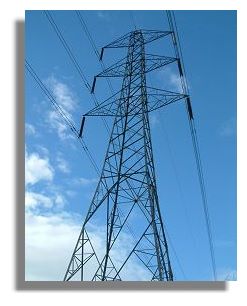Interconnector(s)
 I've just finished reading and digesting the proposal from SHETL for the subsea cable from Lewis to Ullapool. What follows is my opinion, and is not a Council position, and it is probably subject to a lot of further information, so it may yet change.
I've just finished reading and digesting the proposal from SHETL for the subsea cable from Lewis to Ullapool. What follows is my opinion, and is not a Council position, and it is probably subject to a lot of further information, so it may yet change.The SHETL proposal seems to make sense as presented, with the routes clearly justified and rationalised.
But these weren't the questions I was being asked by a poster to this blog. The questions were two fold, and I will try to answer both as completely as I can.
"Why do we need two inter-connectors?"
"If we can get an inter-connector for the Eishken windfarm, why do we need LWP at all?"
The first underlying problem with the SHETL application is that it assumes that the Pairc community windfarm will proceed, and the entire justification is built around that. The Pairc community scheme is on at scoping stage, and is probably at least one year away from consideration by the Comhairle (and then on to the Executive).
The second underlying problem will be whether the community scheme gets supported by the Comhairle or not. When the original applications from LWP and BMP came in, virtually together, we discussed the implications that these applications would have for other potential applications that we thought might be in the pipeline.
At that time (and this conversation was based on the original applications and not the final reduced versions) there was a view in the planning department that the three applications together would be overwhelming on the landscape, and that was a view with which I concurred at the time. Until Planning have sight of the Pairc application, I don't know if this will hold true, but it certainly was a serious concern. In essence, we thought that any two of the three "big" applications were acceptable with modifications, but three was too many. I know many will say one is too many, but I am explaining the process.

The third problem is the pylons. LWP made one combined application for the windfarm and the connection to Arnish, and the Comhairle have requested that the Scottish Executive require all cabling to be below ground. SHETL are applying for pylons, on behalf of two third parties, and this is likely to be even more contentious than the actual windfarm.
Problem four is that the connection is into the Beauly-Denny line. IMHO, it is likely to be five-ten years before any decision is taken on that connection, and any approval is likely to be fraught with objections, conditions and further applications.
-------
The cable that SHETL propose will meet the expected capacity of 600MW from Eishken, Pairc and the other community schemes that have requested a connection. LWP have not requested a connection from SHETL, as they obviously have other plans.
Bear in mind that any future developments, such as wave or tidal will need capacity, and that SHETL are restricted by OFGEM in providing capacity to applicants, and not are not allowed to create capacity for future developments. Further, like any good business, SHETL want the energy to go through their grid on the mainland so they can have the income, rather than what is best for the producer.
-------
In my view, the end game is as follows: Beauly-Denny (and Ullapool-Beauly) is going to be held up for too long, and the subsea connection to Ullapool will never happen.
LWP are going to run a private cable to Hunterston or Cumbria, as an entirely private enterprise, which will not be regulated by OFGEM as to overall capacity or the sale of excess capacity to others.
This cable will have enough capacity for LWP to offer the spare capacity to Eishken and everyone else to subsidise the cost to LWP and to provide the islands with enough capacity for future developments of the West Coast.
In summary, I expect that we will have one cable and that will be the LWP one. I would also expect SHETL to dispute my analysis, as they have to make the business case.
----
This position is one I have been adapting over the past three years, as the situation has changed. It may turn out to be wrong - Beauly-Denny might get approval next year - but in my view it is the one with the highest probability.







3 comments:
Here are my predictions:
Beauly-Denny will be approved without any problem. The fact that the vast majority of people along its route oppose it will make no difference to the decision; after all, Scotland has seen ample evidence that democratic governance no longer exists, from top to bottom. Councils and the Executive trot out the chestnut of 'it'll all be good for the community, and be damned to the locals' complaints, the ignorant cretins'.
So, we can assume that the Reporters' Unit will simply approve this project, as they've already approved so many other absurd and unnecessary wind-related projects.
After all, it's a bit late in the day NOT to approve an upgrade to carry all that (unreliable) electrical generation to the South, isn't it? But of course, we've known all along that this is how it would play out.
So, B-D will be approved, winks and nods and bubbly all around, and yet again the locals will be totally ignored, and made to pay the financial cost in declining property values and decreased quality of life. Makes one wonder why we bother with the charade of elections, truly it does. And politicians wonder why voter turnout is so low....
The Pairc windfarm will be built. The developer will just go up the ladder, to the Executive if need be, to get the proper approval. It's the typical pattern: developer dangles 'community incentives' to get the desired outcome--or is it 'community development funds'--and if they don't get the desired result, they just appeal to the Executive, who will rubberstamp (96% of the time) the developer's wishes.
So assume Pairc will go through, too, even if the Council were to disapprove unanimously. That's something grim to ponder, actually.
Basically, your council vote means nothing in any case. On appeal, wind farms get built--you can pretty much bank on it. A 'yea' vote by a council saves a lot of expense all around, and since the voters have no say in the matter anyway--their councillors often trot out the 'vote their consciences' excuse rather than actually represent their constituents's wishes--it'd be easier to dispense with the whole charade and just rubberstamp whatever the wind farm scammers want.
And that's the way it really, truly is--all you need do is look at the blight of useless, non-productive, non-CO2 saving wind factories springing up all over Scotland despite the most vociferous opposition from communities everywhere.
Frankly, since you seem to be an ethical chap, I'd advise you to get out of politics altogether--you're too good for it, by a long chalk.
Angus, you have obviously thought this through properly and thoroughly. Respect is due for that. Don't agree with Anon's pessimism. Keep up the good work.
Angus, you have obviously thought this through properly and thoroughly. Respect is due for that. Don't agree with Anon's pessimism. Keep up the good work.
For pro-wind advocates, my comments should be welcome news.
BTW, it's not 'pessimism' to state simple facts. With what assertions of mine do you take issue, Anon?
Post a Comment